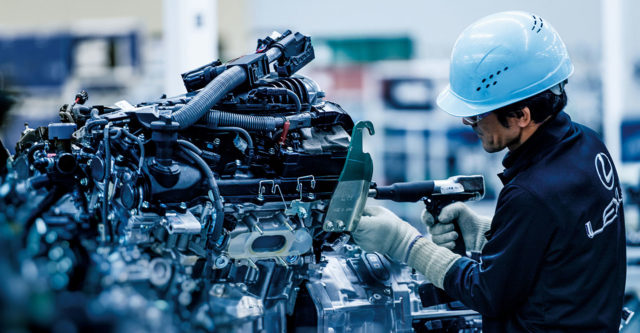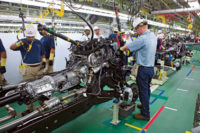The Toyota Production System (TPS) revolutionized manufacturing worldwide. Today, its application goes beyond manufacturing, impacting transactional processes from healthcare services to software design.
The TPS is, in fact, a multidisciplinary science that can be taught and applied more widely—not just to business haphazardly, but systematically to the broader aspects of our economies. I would argue that it offers solutions to the pervasive financial, socioeconomic and environmental contradictions in today’s society.
Unfortunately, its technical and managerial innovations are inadequately understood and applied. Many leaders do not clearly grasp the full scope of benefits that TPS offers. Instead, they choose elements of it and apply them with limited financial, social and economic effects.
By 1938, Toyota “inversed” industrial thinking amid the mass production system boom. It was decades ahead of the need to create a production system that is better adapted to a diversified economy of variety than a uniform economy of scale. And, it remains relevant today.
Before the COVID-19 pandemic and the resulting parts shortages, Toyota had the foresight to safeguard against shortages of vehicle computer chips. Doing so is much easier and less expensive when manufacturers eliminate having to supply from inventory. To make a simple analogy, when you are not used to eating sugar, a little of it goes a long way.
In 1998, Fujio Cho, then president of Toyota, announced the North American development of the new Toyota Sequoia SUV to compete against the best-selling Ford Explorer. Sales of SUVs were booming, gas was cheap, and global warming was not yet part of the public zeitgeist. Yet, one of Cho’s proudest moments was his championing of the launch of the first hybrid vehicle in Japan, the Toyota Prius. Today, the production of Toyota hybrid, electric, and hydrogen engines continues to align with the global need for clean energy.
As Toyota continues to meet the business, social and economic needs of our changing world, it seems evident that something more is at work with TPS than just making cars.
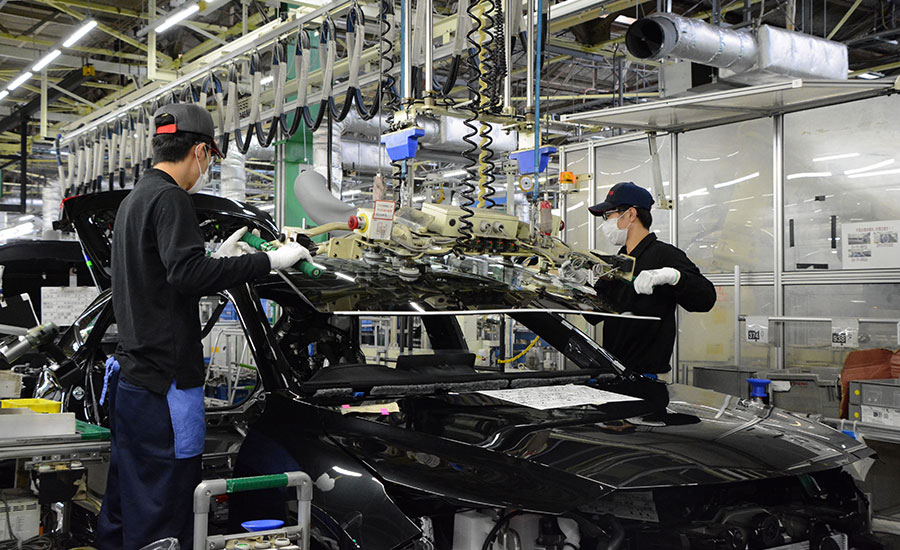
The TPS fuses the benefits of craftsmanship with the benefits of mass production, while eliminating the undesirable elements of both. Photo courtesy Toyota Motor Corp.
Best of Both Worlds
The TPS combines philosophical, technical and managerial principles that fuse the benefits of the old method of craftsmanship with the benefits of the newer mass production system, while leaving behind the undesirable elements of both.
Craftsmanship is flexible but expensive. Until the late 1700s, craftsmanship was the production method. It aggregates processes, usually in one location with a few skillful experts. It delivers exactly what a customer wants when he wants it, but it was slow, expensive and not scalable.
Mass production is less expensive, but inflexible. It favors disaggregating processes. Machines are designed and organized by function, instead of the flow of work. It aims to quickly produce large quantities of uniform products to increase revenue and reduce production and delivery costs through economies of scale. As Henry Ford famously said, “Any customer can have a car painted any color that he wants so long as it is black.”
Today, companies offer many product varieties across many industries. Product variety creates value, but when it’s coupled with rigid mass production, it also creates waste and displaces other costs onto society because machines are less flexible than people. In other words, rigidity is imposed when a mass production system tries to maintain its prevailing goal of individual asset efficiency. Increasing product variety thus forces management to choose between stopping for equipment changeovers or running large batches. In batch production, we must choose between delaying deliveries or carrying inventory, since assets are tied up producing one variety while others are waiting.
Unfortunately, neither delaying deliveries nor producing to forecast to compensate for long lead times demonstrates flexibility.
The TPS takes the best of what each system has to offer. Toyota’s leadership understood the limitations of each method, so they engaged shop floor personnel early on to reconcile the conflicting objectives of achieving both flexibility and mass production.
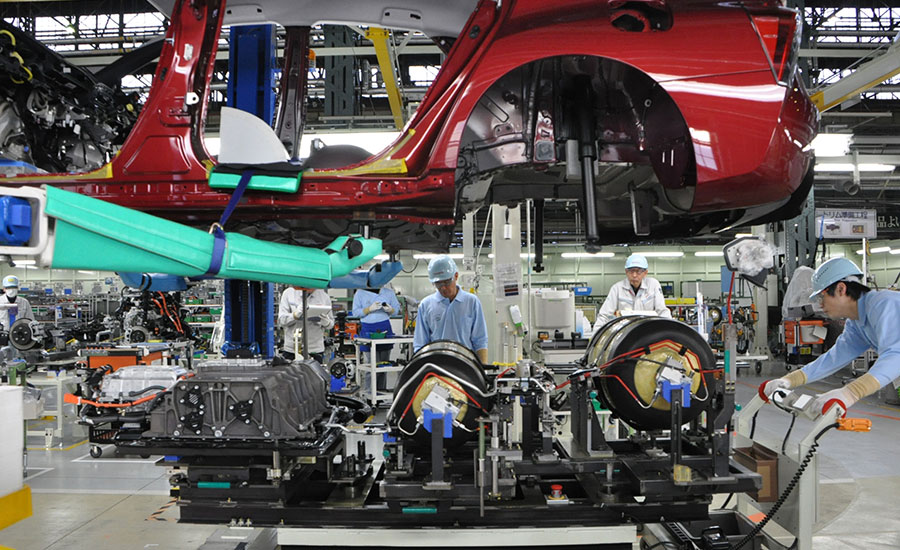
As a production system, TPS is an economic model that is conciliatory and humanitarian. Photo courtesy Toyota Motor Corp.
Philosophical Elements of TPS
Reconciling mass production and flexibility requires a different type of thinking and a consistent purpose that is not sustainable without clear economic principles. As a production system, TPS is an economic model that is conciliatory and humanitarian. It sits on a different philosophical principle of efficiency called “basic thinking”—so much so that the term “wrong thinking” became idiomatic in the TPS vernacular of my Toyota managers. While I was working at the Toyota Supplier Support Center in Erlanger, KY, in the late 1990s, nothing mattered more to my Toyota leaders than correcting my wrong thinking. Toyota’s basic thinking avoids favoring individual efficiency because it can lead to forced work and apparent efficiency.
Individual asset efficiency for earned hours and revenue is forced work. This is a drastic departure from mass production thinking, which measures individual efficiency or how much an asset produces, regardless of when the customer needs it. However, producing anything outside of satisfying when and what the customer wants is overproduction, and overproduction is waste.
Forced work leads to apparent efficiency. Forced work increases output and revenue, and it might reduce individual asset and production costs. However, the end result is apparent efficiency because the focus on individual efficiency leads to producing large runs of uniform products when alternating small runs of diversified products are needed instead. Large batches impose an operational rigidity that creates unnecessary direct costs and, most importantly, creates and displaces other indirect costs.
The direct cost of unevenness in the schedule, as machines and workers operate to their own rhythm, results in planning irregularities and work detached from customer demand.
The direct cost of waste comes from obsolete goods produced to forecasts, inventory stored in warehouses requiring conveyance, and unnecessary human activity. It ties up cash, hides defects, and compromises future revenue.
Cumulatively, this type of poor resource allocation leads to the direct cost of overburden on people and machines. Even more concerning are the indirect costs to society, including unsustainable environmental pollution, which contributes to disease, biodiversity loss, soil death and climate change.
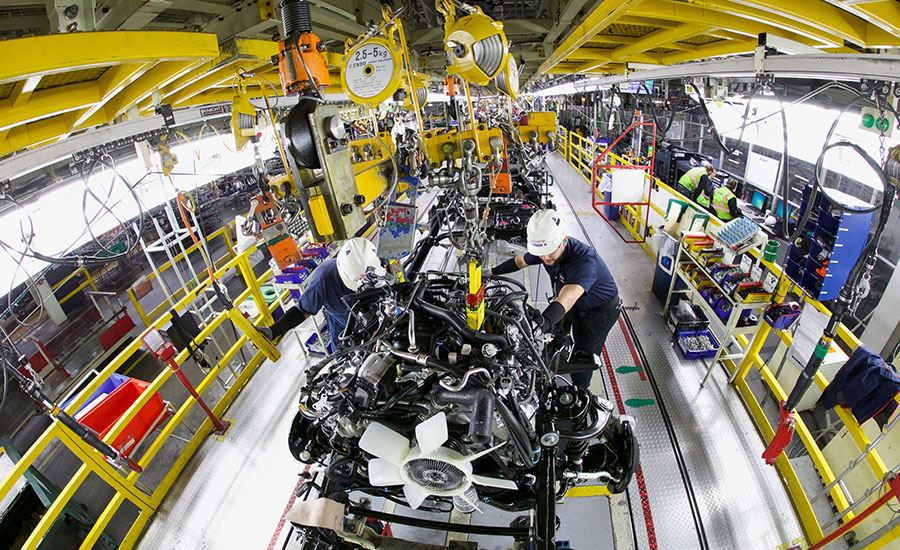
With its relentless focus on eliminating waste, TPS offers solutions to the conflict between the need for profit and sensible environmental stewardship. Photo courtesy Toyota Motor Corp.
The Economic Philosophy of TPS
Instead, Toyota’s basic thinking focuses on three different principles of efficiency. The first addresses total efficiency. The second addresses eliminating unevenness in the schedule, waste in work, and overburdened assets. The third addresses true efficiency.
Total efficiency encapsulates the goals of achieving the highest quality, the lowest cost, and the shortest lead time of products and services from order acceptance to delivery. Not one of these factors can be overly weighed against the others. Rather, all three must be achieved to their utmost.
This means keeping to the philosophical discipline of not giving higher weight to any factor, the way mass production does with individual asset efficiency, earned hours and revenue. It also means applying science to eliminate “unevenness, waste and overburden” instead of forcing work and settling for compromises of apparent efficiency, like the economic order quantity method and oversimplified return of investment calculations.
Apparent efficiency is the immediate perception of gain and benefit when, in fact, less visible costs are displaced or new costs are created with payment due later. Standards of living have improved worldwide, but is this true for everyone and will future generations have a planet to enjoy it?
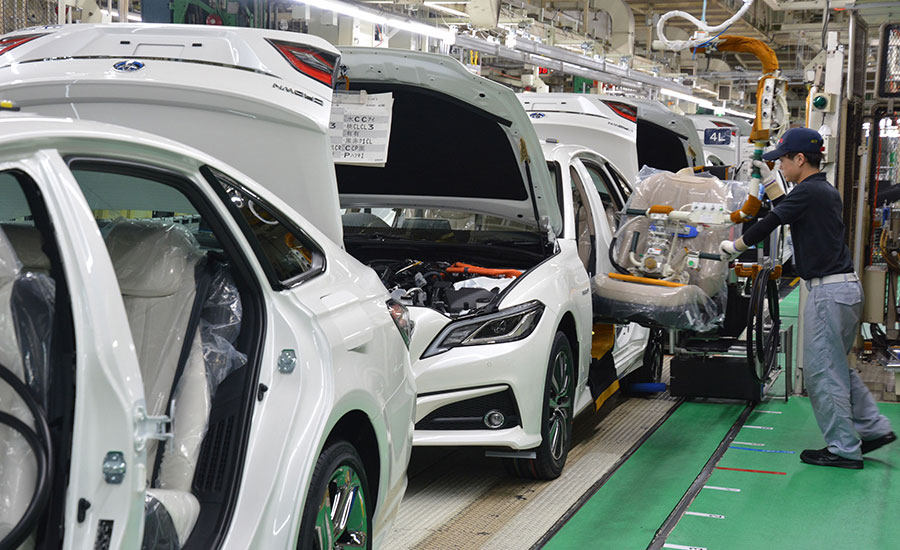
TPS eliminates layers of unevenness, waste and overburden by deploying the “stop and notify” method, a process designed to make problems visible early so they can be solved quickly. Photo courtesy Toyota Motor Corp.
Technical Elements of TPS
TPS brings together a series of industrial designs that, when applied together, eliminate the trade-off between the goals of high quality, low cost and short lead-time. Financially, it translates to simultaneously meeting the need for profit, as reported in the income statement, and the need for operating cash flow, as reported in the statement of cash flow. Indeed, generating a profit is only one of a business’s challenges. Another is to generate cash quickly enough to pay the bills on time! In mass production, those two requirements conflict because revenue and flexibility are at odds.
To satisfy the need for profit and cash flow simultaneously, we must produce quality products and services to generate revenue from sales, we must reduce end-to-end value stream costs to increase profit margins, and we must shorten lead times to generate cash.
TPS eliminates layers of unevenness, waste and overburden by deploying the “stop and notify” method, a process designed to make problems visible early so they can be solved quickly by experts when and where they occur. Ideally, this is done autonomously.
Simultaneously, TPS requires one-piece continuous flow, a process designed to eliminate work stagnation.
Together, these two procedures support each other in a symbiotic system to reduce the lead time and free the rate of supply to match the rate of pull.
Shorter lead times make it possible to design and produce goods or services closer in time to actual customer needs, instead of relying on uneven and overburdening longer-range forecasts. Actual customer demand becomes the new shared operational data point, known as takt time. Knowing takt time enables management to determine how many people, machines and materials are needed to meet demand without wasting resources.
Other principles of the TPS include jidokam just-in-time manufacturing and heijunka. Jidoka is the idea of building quality into the process. Just-in-time is the idea of enabling quick response to change by only building what is needed, when it is needed, in the amount needed. Together, jidoka and JIT eliminate unevenness in production schedules, overburden on assets, and waste in work. Heijunka is leveling the type and quantity of production over a fixed period of time. This enables production to efficiently meet customer demand.
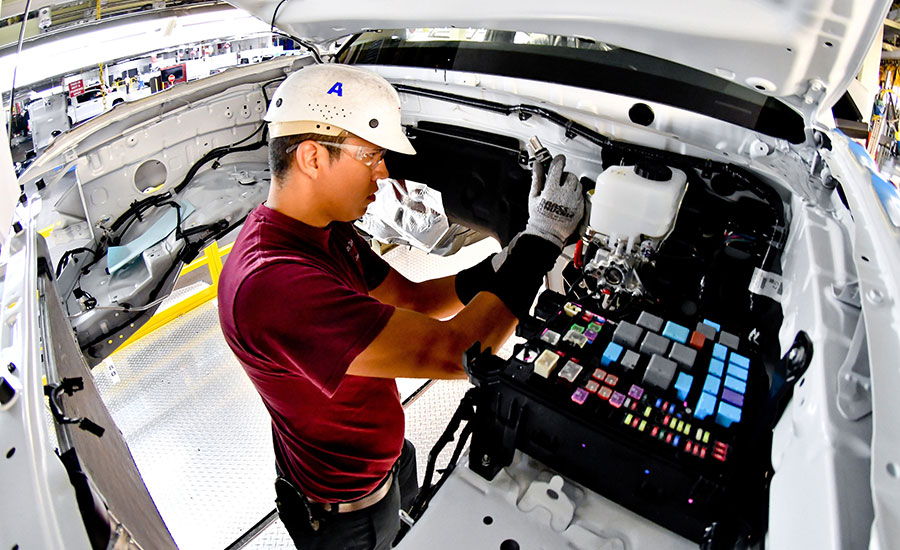
The TPS respects and honors humanity by cultivating meaningful, satisfying work to build self-worth. Photo courtesy Toyota Motor Corp.
The Managerial Element of TPS
The TPS requires a different managerial approach than the one offered by the mass production system. Specifically, Toyota worked to reconcile the creative nature of people with the repetitive and mundane requirements of industrial work. This requires developing workers who can work as a team while also becoming expert craftsmen at what they do. The TPS reintroduces craftsmanship into an industrial setting—not in the same way, to be sure, but with the same importance.
In mass production, machines triumphed over labor. People took a back seat, and machines became the most valuable asset. At the time, mass production was the best we could do to meet the world’s seemingly unlimited demand for essential goods. At first, people benefited from the system by giving up their skills for increased living standards. Now, we realize the system’s limitations.
Entering the age of artificial intelligence, humanity will continue to be tested in even more challenging ways. The TPS can continue to play a critical role in reconciling the needs of business and people by embracing worker expertise at all levels, instead of frittering it away.
In the TPS, workers learn to leverage new thinking and techniques to perform quality work efficiently and anticipate problems before they happen. If problems do occur, workers can identify and solve them rapidly and efficiently through a shared framework and knowledge consistent with eliminating unevenness, overburden and waste.
On the one hand, it takes expertise to spot problems; on the other, no one who acquires expertise likes to waste it. This symbiotic relationship between the work people do, and their expertise enables people to reach their full potential and contribute toward the meaningful goals of highest quality, lowest cost, and shortest lead time. Therefore, the TPS respects and honors humanity by cultivating meaningful, satisfying work to build self-worth.
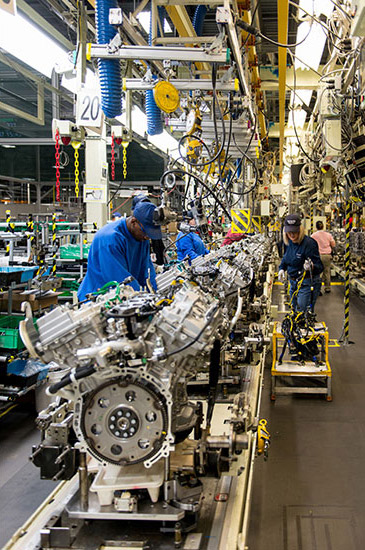
Chasing profit from economies of scale implies higher output and reduces individual asset costs. But a higher output of what is not needed is wasteful. Photo courtesy Toyota Motor Corp.
Environmental Innovation
With its relentless focus on eliminating waste, TPS has brought about a third innovation to the larger aspect of our economies. It offers robust solutions to the conflict between the need for profit and sensible environmental stewardship. Society has a moral responsibility and the economic imperative to teach that chasing revenue by favoring individual machine efficiency at the expense of everything else is obsolete way of making a profit.
Chasing profit from economies of scale implies higher output and reduces individual asset costs. But a higher output of what is not needed is wasteful. To produce is to deplete resources and emit pollution. We must also remember that, sooner or later, the things we make are destined to be discarded or trashed.
When this kind of wrong thinking remains unchecked, thinner margins impede profits over time because all products succumb to commodity pricing. Thinner margins force businesses to merge to keep revenue increasing and delocalize work to lower-wage markets to maintain a profit—places where the workforce must accept less-than-dignifying work, disconnected from the customer. Complex, expensive, fragile and polluting supply chains emerge, and services disappear, leaving consumers with few options and no competitive market forces to keep prices in check.
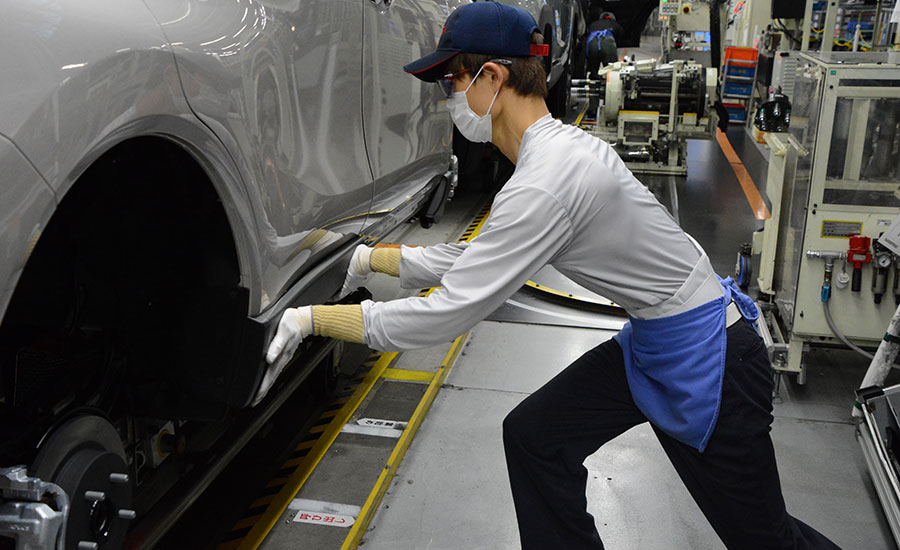
Manufacturers must learn how to make only what is needed—and to do it with less. Photo courtesy Toyota Motor Corp.
Reshoring and Economic Stability
Before joining Toyota, I worked in Silicon Valley with many semiconductor manufacturing plants. Once, the U.S. was a leader in semiconductor manufacturing. Today, 75 percent of semiconductors are manufactured in Asia. Of course, it’s not just semiconductor industry that has moved offshore. Scores of companies across all industries have done so primarily because they lack the knowledge of how to operate efficiently.
The erosion of a strong domestic manufacturing sector was a contributing factor to why the United States has endured two economic crises in the past 12 years. These crises required unprecedented institutional interventions to mitigate a rigid industrial economy that lacks resilience due to radical asset individualism and the waste it generates. Today, manufacturers are disconnected from demand. Suppliers are disconnected from their customers. Value has been disconnected from true wealth creation, and common sense has been disconnected from environmental stewardship.
Instead of repeating the past, could there be a better way forward? We must learn how to make only what we need—and to do it with less. That is true cost reduction. Besides helping the balance sheet, it will generate significant socioeconomic benefits. It will free industries from overreliance on economies of scale to reduce cost and fuel economic growth, and it will eliminate the need to shift the undesirable costs of environmental pollution onto others. Producing only what we need, with fewer resources, can help us achieve true economic prosperity.
A sound economic framework and the coherent relationship between TPS’s philosophical, technical and managerial elements are undeniably part of Toyota’s corporate culture. This culture has sustained the long-term organizational consistency of purpose necessary to design and produce quality, affordable products only when needed and as geographically close to the customer as possible.
The result is a congruent relationship between the interests of the firm, the employee, the consumer, and the environment. Realizing such shared consistency of purpose and harmony between traditionally divergent interests is no small feat; it took thousands of years to achieve.
Organizations cannot achieve Toyota-like levels of operational maturity overnight. But, they will never realize their full potential if TPS remains a collection of practices to help leaders to think only in terms of trade-offs instead of congruency. We don’t have to start solving our business and socioeconomic contradictions from scratch. The TPS has already solved key areas by rethinking how we design, organize and manage work.
Editor’s note: Olivier Larue is a senior executive consultant and president at Ydatum Inc., which partners with public corporations and private equity clients in operation design and management. He has more than 30 years of hands-on experience with the TPS. He worked with the Toyota Supplier Support Center in North America, the Toyota Operations Management Consulting Division, and New United Motor Manufacturing before founding a consulting firm in the Bay Area focused on implementing TPS in a variety of industries.
He is the author of the new book, The Toyota Economic System. He will present a free webinar on the TPS on Tuesday, Oct. 3.
ASSEMBLY ONLINE
For more information on Toyota’s manufacturing technologies and practices, read these articles:
Toyota Unveils New Generative AI Technique for Vehicle Design
Smart Technologies Aid Continuous Improvement Efforts
Assessing the Current State
